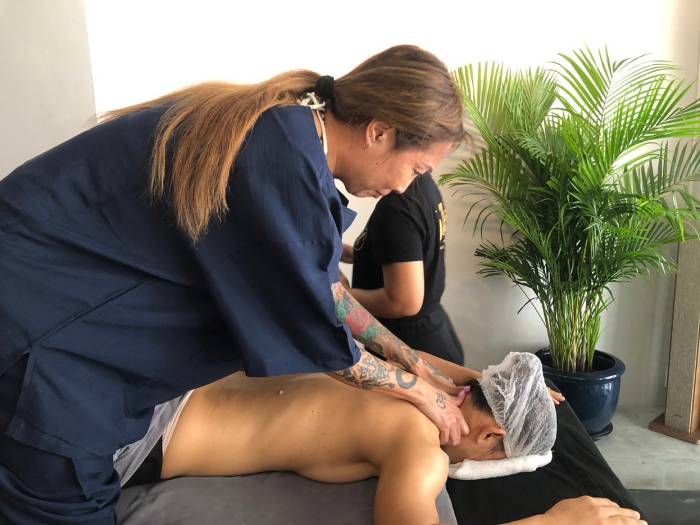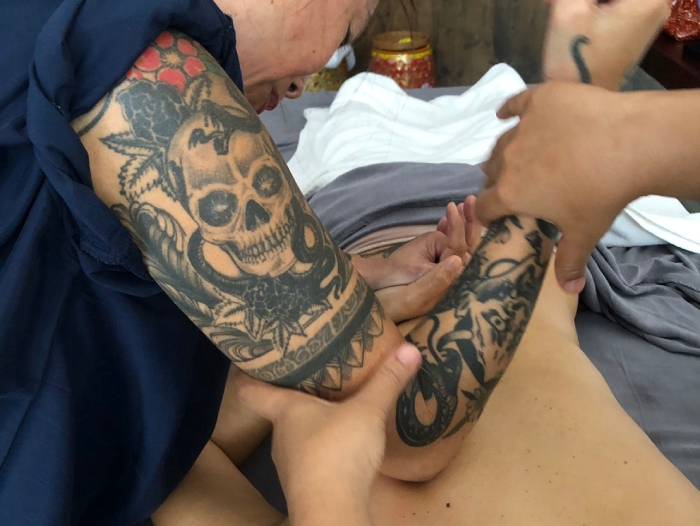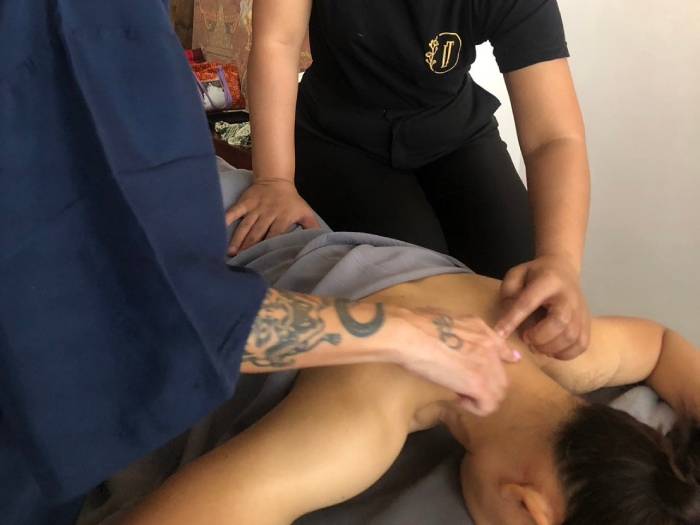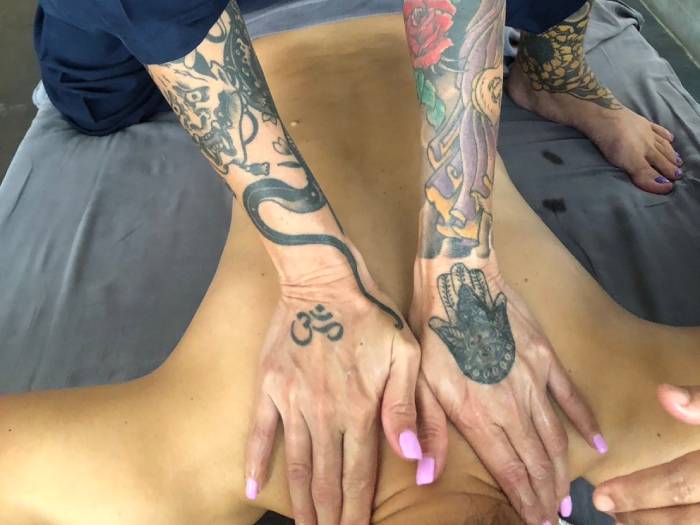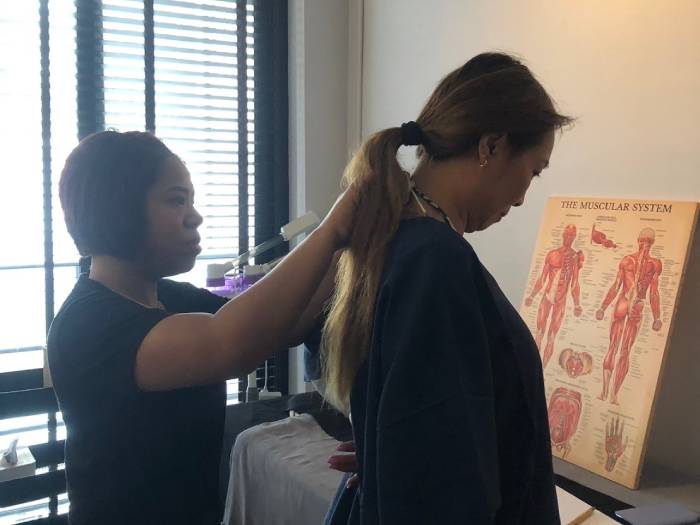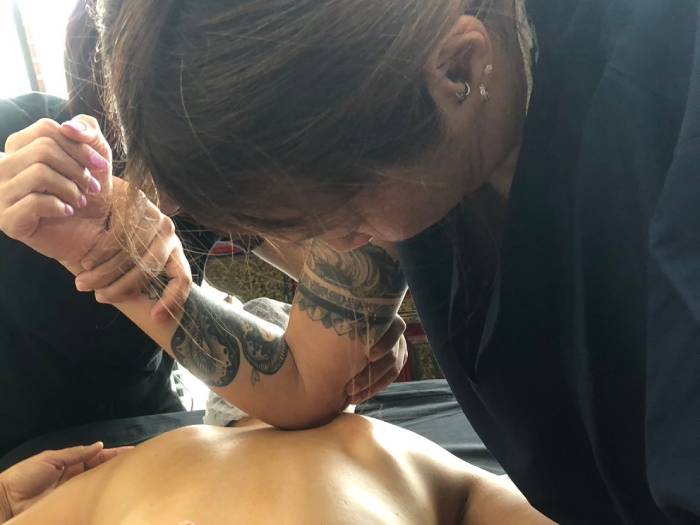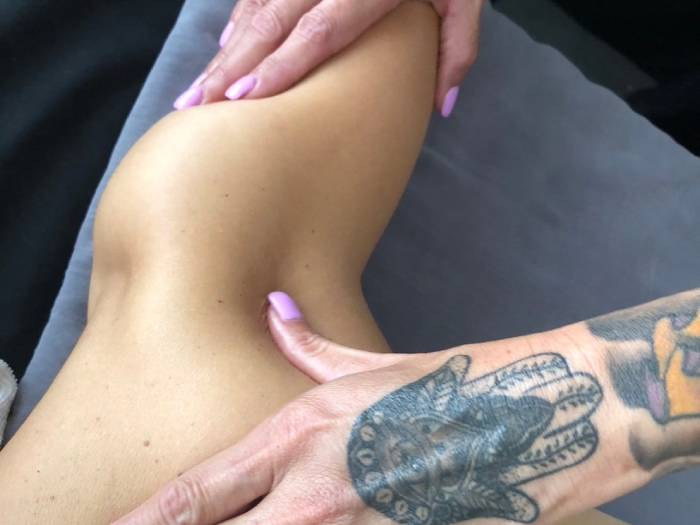Healing the Modern Worker with Traditional Wisdom
The Office Syndrome Massage Course offered at our Bangkok-based massage school is a specialized training designed to address one of the most widespread physical ailments of the 21st century. With the rise of sedentary lifestyles, long hours at desks, and screen-based occupations, more and more people are suffering from what is commonly referred to as Office Syndrome—a complex of muscular pain, postural imbalances, and stress-related discomfort caused by poor ergonomics and repetitive movement.
This comprehensive course equips students with the knowledge and techniques needed to relieve these symptoms using a fusion of traditional Thai massage, trigger point therapy, and modern muscle release techniques. Whether you’re a professional therapist seeking to expand your skill set or a beginner wanting to enter the field of therapeutic massage, this course provides everything you need to start offering practical and effective treatments that are in high demand in today’s wellness and corporate sectors.
Set in the vibrant city of Bangkok, specifically in the culturally rich and internationally accessible district of Sukhumvit, our school offers the ideal environment to learn, practice, and refine your therapeutic skills in a professional and culturally immersive setting.
Bangkok and Sukhumvit – The Ideal Setting for Therapeutic Learning
Bangkok is widely regarded as a global capital of traditional Thai massage and holistic healing. It’s a city where ancient wisdom meets modern wellness trends. From temples offering traditional treatments to five-star hotel spas with globally trained therapists, Bangkok is a true melting pot for learning the healing arts.
Located in Sukhumvit, one of Bangkok’s most dynamic neighborhoods, our massage school is easily accessible via BTS Skytrain and surrounded by wellness cafés, yoga studios, co-working hubs, and boutique spas. Sukhumvit is also home to countless professionals, digital nomads, and entrepreneurs—the very people most affected by Office Syndrome. This makes the area not only an ideal location for learning but also for gaining firsthand insights into your future clients.
Training in this area gives students the opportunity to experience the modern pressures and postural demands of today’s lifestyle, while learning techniques rooted in centuries of Thai tradition.
Understanding Office Syndrome – A Modern Condition
Office Syndrome is not a single diagnosis but a collection of physical symptoms resulting from poor posture, prolonged sitting, repetitive movements, and insufficient muscular support. It is especially prevalent among office workers, students, and anyone who spends extended periods in front of a computer, phone, or other screen-based device.
Common symptoms include:
- Neck stiffness and tension
- Chronic shoulder pain (especially in the trapezius area)
- Upper back tightness
- Headaches caused by muscle contraction
- Wrist, elbow, and forearm pain from typing or mouse usage
- Hip and lower back pain due to prolonged sitting
- Poor blood circulation and numbness in limbs
Left untreated, Office Syndrome can lead to postural degeneration, chronic fatigue, emotional stress, and even nerve compression. The growing demand for non-invasive, hands-on therapy to treat this condition makes this course a valuable addition to any therapist’s practice.
Course Preparation – What to Expect and How to Get Ready
Students enrolling in this course should bring with them a passion for healing and a commitment to hands-on learning. No prior experience is required, but those with a background in massage therapy, physical fitness, or anatomy will find the material particularly enriching.
Training is conducted in a traditional Thai massage environment. The sessions take place on floor mats or massage beds depending on the technique taught that day. The space is quiet, clean, and designed to support both concentration and comfort. Each student will be given access to all the necessary equipment and receive printed course materials for review.
We recommend that students wear loose, breathable Thai-style clothing to facilitate movement. Since Thai massage involves deep stretches and body-weight-based pressure, comfortable attire is essential for both learning and giving treatments.
Cleanliness, personal grooming, and punctuality are emphasized to reflect the professional standards expected in therapeutic settings.
Tools and Equipment Used in Office Syndrome Massage
While traditional Thai massage relies primarily on body mechanics—hands, elbows, thumbs, and feet—this course also introduces specialized equipment to support targeted muscle release:
- Hot Stone therapy for deep muscle relaxation
- Herbal Compress balls to ease tension and inflammation
- Tok Sen Massage tools for deep vibrational therapy
- Massage mats and adjustable tables
- Bolsters and cushions for posture support
- Wooden massage sticks for pressure point activation
- Warm herbal compress balls for muscle softening
- Trigger point charts and anatomical diagrams
- Thai herbal balm for muscle and joint relief
Students are trained not just in using these tools, but in understanding when and how to apply them for maximum therapeutic effect.
Step-by-Step Training – Learning to Relieve Pain at its Source
One of the most engaging aspects of this course is the detailed, hands-on learning experience. Every class builds upon the previous, beginning with the foundations of posture, alignment, and anatomy, then moving into precise techniques for muscular release and energetic balance.
The course begins with an overview of muscular anatomy, focusing on areas commonly affected by Office Syndrome: the cervical spine, shoulders, thoracic region, hips, glutes, and wrists. Students learn how muscular imbalances create strain patterns and how these can be relieved through targeted massage techniques.
The Sequence of Treatment
- Client Assessment and Postural Analysis: Students learn how to read body posture, identify muscular imbalances, and ask relevant questions to design a personalized massage approach. Visual and tactile assessments are key to determining which muscles are overactive, tight, or underused.
- Neck and Shoulder Release: This section addresses one of the most common pain zones. Using thumbs, palms, elbows, and forearms, students learn techniques to release the trapezius, levator scapulae, and sternocleidomastoid muscles. Gentle stretching and trigger point therapy are introduced to dissolve tension.
- Upper Back and Thoracic Area: Students are taught to apply slow compressions and cross-fiber friction to the rhomboids and erector spinae, releasing tension caused by rounded shoulders and a forward head posture.
- Arm and Wrist Work: Repetitive stress from typing and computer work can affect the forearms, elbows, and wrists. Students learn how to perform gentle traction, muscle stripping, and joint mobilization to relieve carpal tunnel-like symptoms.
- Lower Back and Hip Alignment: Prolonged sitting causes weakness and tightness in the lumbar spine and hip flexors. This section includes side-lying and prone techniques to access the quadratus lumborum, glutes, and piriformis, restoring flexibility and alignment.
- Leg Circulation and Nerve Flow: Office Syndrome can affect blood flow and nerve health in the legs. Students learn gentle techniques to improve circulation and reduce swelling in the feet, especially when paired with herbal compress therapy.
- Client Aftercare and Stretching Guidance: The final part of the training includes guided self-care techniques that therapists can teach clients for long-term relief. These include breathing exercises, desk-based stretches, and lifestyle tips to prevent recurrence.
Throughout the course, students practice giving and receiving the massage under supervision. Emphasis is placed on correct body mechanics, rhythm, and communication, ensuring that therapists work safely and sustainably.
Contraindications and Safety Measures
While Office Syndrome Massage is generally safe and beneficial, there are important contraindications and precautions students must understand. These include:
- Severe spinal disc herniation
- Uncontrolled high blood pressure
- Recent surgeries or fractures
- Severe varicose veins
- Thrombosis or vascular disease
- Infections, fevers, or systemic inflammation
- Pregnancy (requires separate training and adaptations)
Students are taught how to screen clients, identify red flags, and refer to a medical professional when necessary. Modifications and gentle techniques are provided for sensitive or elderly clients, ensuring treatments are personalized and safe.
Benefits of the Training – For Therapist and Client
This training empowers therapists with highly practical, in-demand skills that can be applied in a wide range of settings. With remote work and sedentary lifestyles on the rise, the demand for bodyworkers trained in office syndrome relief is rapidly growing.
For the Client, the Benefits of Office Syndrome Massage Include:
- Reduced tension and pain in neck, shoulders, and back
- Improved posture and body awareness
- Better sleep and energy levels
- Enhanced concentration and focus
- Relief from repetitive strain injuries
- Improved blood flow and nervous system regulation
For the Therapist, Learning this Technique Provides Access To:
- Corporate wellness programs
- Private clients
- Physical therapy centers
- High-end spa environments looking to expand their therapeutic offerings
Recommendations for Students
Students are encouraged to maintain personal wellness routines such as stretching, yoga, and meditation to better understand the postural stress they are treating in others. Regular self-practice ensures empathy and helps prevent burnout.
We also recommend observing real clients or case studies, particularly in co-working spaces or offices. This helps students recognize how Office Syndrome manifests in everyday people and improves their diagnostic intuition.
Students who combine this course with others—such as Thai massage, sports massage, or aromatherapy—develop a more holistic and versatile professional profile.
What You Can Do After the Course
Upon successful completion of the course, students receive a certificate of training from our massage school in Bangkok. This certificate recognizes their proficiency in treating Office Syndrome through therapeutic bodywork.
Graduates go on to:
- Work in spas and wellness centers with therapeutic services
- Join corporate wellness programs
- Offer mobile massage sessions in office settings
- Add Office Syndrome treatment to their private practice
- Combine this massage with physical rehabilitation, sports massage, or yoga therapy
Some graduates also create educational content or workshops for office workers, expanding their offerings beyond hands-on sessions. Others incorporate herbal balms and Thai compresses to create unique therapeutic treatments for recurring clients.
Healing the Strain of the Modern World
The Office Syndrome Massage Course is more than a technical certification—it is an opportunity to become part of the solution to one of today’s most common and debilitating physical conditions. Rooted in the wisdom of Thai healing and enhanced by modern anatomical knowledge, this training offers students a unique skillset that is both practical and transformative.
By studying in the heart of Sukhumvit, Bangkok, students benefit from cultural immersion, hands-on experience, and direct connection with the real needs of the modern world. Whether you’re just starting your journey or expanding your healing practice, this course will equip you to bring comfort, relief, and balance to clients everywhere.
Please note: This course description is intended as a general guideline. Actual course structure, curriculum, materials, and content may vary depending on the student’s background, individual goals, and evolving teaching methodology. Our team tailors each training to ensure the best learning outcomes for all participants.
If you would like to experience the Office Syndrome Massage performed by a professional therapist, we highly recommend booking a session with our partner Loft Thai Boutique Spa & Massage. Their experienced team offers authentic treatments in a serene and luxurious setting. To explore and book your session, please visit the link below. All students from Nuad Thai School are entitled to an exclusive 20% discount on all treatments.
Pricing
Packages made for anyone!
Thai Discover
- 4-hours group course
- Instructor & Model
- Introduction & Theory
- Thai Massage Practice
- School Certification
Thai Beginner
- 4-hours private course
- Instructor & Model
- Introduction & Theory
- Thai Massage Practice
- School Certification
Thai Professional
- 150 hours private course
- Instructor & Model
- Professional Training Course
- Custom or Tailor-Made
- Official THAI UTTS Certification

